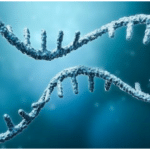Transduction is a procedure of genetic recombination in bacteria. It is the genetic or DNA transfer from a bacteria to another virus through a recipient bacterium. There is no such direct contact among the cells of bacteria. Transduction can also be possible through conjugation and transformation. In transduction, the virus particle infects the bacteria. It is known as phage or bacteriophage and as the DNA transfers, it is known as transfusing phages. Transduction takes place only when the DNA transfers tens to hundreds of kilobases of such elements. The process of genetic movement is advantageous over other processes like conjugation as it does not need any sort of physical contact between the cells receiving and donating the DNA. Again, transduction resists the DNase enzyme while transformation cannot resist such DNase. Transduction was discovered by Lederberg and Zinder while Chase and Hershey used transduction as a means to use DNA as a genetic determinant.
Transduction vis-à-vis Transformation and Conjugation
Steps of Transduction in Bacteria
Transduction in bacteria engages the transfer of the DNA through viral infection. The plausible steps for transduction in bacteria are as follows:
- Transduction in bacteria is based on the process to infect the bacteriophage.
- The donor DNA of the bacteria is inculcated into the bacteriophage either through the lysogenic or lytic cycle.
- In transduction, as the bacterial DNA gets inculcated into the phage, new phages are developed from such bacterial cells.
- The newly developed phages taint the host bacterial cell. Then the phages engaged to a specified bacterial cell inject the DNA having the cells of the donor DNA into the cytoplasm of the host cell.
- Transduction in bacteria depends on the nature of the phage. The DNA assimilates into the bacterial genome to replicate the cytoplasm. This could be in terms of plasmid or the replication can take place immediately developing phage progeny.
Steps of Transduction in Bacteria
Kinds of Transduction in Bacteria
Bacterial transduction is common to both temperate and virulent phages, say through the lysogenic or lytic cycle. Transduction in bacteria is of two types – Generalized Transduction and Specialized Transduction.
- Generalized Transduction
In the transduction process, generalized transduction takes place quite normally either through the lysogenic or lytic cycle. The random DNA gets assimilated in bacteriophages mistakenly by the viral genome. Generalized transduction occurs at the lytic phase of the phage life cycle. The DNA of the bacteria containing the virus infects another cell. Then it is implanted into the host genome or maybe a plasmid leading to its suitable reformation. Generalized transduction in bacteria is used for gene mapping, linking information, mutagenesis, and comparing genomes of two dissimilar bacteria among others. E. coli transduction through the P1 phage is an ideal example of generalized transduction. The phenomenon can transduce the DNA of the E. coli chromosomes into various Gram-negative bacteria.
- Specialized Transduction
Specialized transduction takes place only through the temperate phage or lysogenic cycle. Only certain parts of the bacterial DNA are considered for the virus infection. Specialized transduction in bacteria takes place as the viral DNA or prophage is implanted into the bacterial genome of the lysogenic cycle expurgates. The bacterial DNA from the prophage gets expurgated, then certain elements of bacterial DNA edged on both sides of the prophage also gets expurgated. The newly developed phage genome from the specialized transduction process contains both viral and bacterial genomes. Then the virus characterized by recombinant genome contaminates the new bacterial cell. The phenomenon inserts the bacterial gene into the host genome having the viral genome using lysogeny. After that, the recipient cell shows the newly developed physiognomies. Specialized transduction in bacteria is suitable for the segregation and enclosure of the preferred genes. E. coli phage lambda (λ) is an ideal example of specialized transduction in bacteria. The transducing phage incorporates the DNA specifically among the operons encoding enzymes. The phenomenon is responsible for adequate exploitation of biotin (bio) and galactose (gal) in the E. coli chromosome.
Steps of Transduction in Bacteria
Usage of Transduction in Bacteria
Transduction in bacteria is a significant determinant in genetic engineering as the preferred genes can be inculcated in the selective choice of plants and animal cells. It modifies the genetic components to extract the anticipated outcomes for gene therapy and cure various genetic diseases. Transduction in bacteria is quite useful to conduct research in molecular biology and genetics.
20.01.22





